|
|||||||||||||||||||||||||||||||||||
Second one's the charm
Star Trek II: The Wrath of Khan
Ace story writer Harve Bennett spent months screening 16mm copies of all the original Star Trek TV shows. At the end, he makes an observation: The "core" of the show is the Kirk-Spock-Bones trinity. Things really come together when Bennett sees Ricardo Montalban guest star in the TV episode "Space Seeds" as Khan, the charismatic, genetically engineered man who ends up exiled by Kirk and crew to an inhospitable planet. Picking up that story line, with the same actor, was the catalyst for Khan the movie.
Clearly, Montalban is the man for this movie. He steals the scene whenever he's in it and manages an interestingly developed hate relationship with Kirk, even though they never share a scene together. Director Nicholas Meyer infuses the Star Fleet fiction with a very nautical feel. This fit so well that it became part and parcel of the Star Trek universe, as evidenced by the influence in subsequent films and the various next generation TV series.
The quintessential Star Trek movie, Khan is today part of pop culture as Seinfeld's George is recalled saying sorrowfully "...hell of a thing when Spock died." The Director's Edition Unlike the previous Star Trek Director's Edition (Star Trek The Motion Picture), there is precious little information included to say exactly what was redone or re-cut in the film, so we asked the people at Paramount. We're told the additional material contained in the Director's cut first appeared in TV versions of the film. This cut measures about 3 minutes longer than the theatrical release. Extras
Disc 2 starts out with a series of new cast and crew interviews, titled "The Captain's Log". The sound bites are rather plainly presented, but the content is so candid that it not only offers worthwhile insights into the film, but also into the background dynamics. Noteworthy are comments made by Shatner regarding an alleged conspiracy by Nimoy and the writers to "set up" Spock's return in the next picture. There is a short but interesting segment titled "Designing Khan" which deals with the art department's contribution to the film. As a film lover all my life, I've only recently begun to appreciate the importance that the Production Designer and Art Director have in a movie. They are the unsung heroes of motion pictures, and it's nice to see them get some exposure like this. "The Visual Effects of Star Trek II: The Wrath of Khan" is another segment I wish was a little longer. Through interviews with the people from ILM who worked on Wrath of Khan, we get just a glimpse of special effects the way they once were before the computer took over.
Lastly, there is "The Star Trek Universe", a montage of sound bites from the interviews of two Star Trek authors. Its not very engaging and will likely be of interest only to the most avid Star Trek universe fan. On the whole, there is a fair compliment of supplemental material, though I wish there were a more comprehensive "making of" feature as well as material covering the Director's Edition. Note: In a refreshing change from the ordinary, with the exception of the 1982 interviews, all the supplemental material is 16:9 enhanced. Yeah! The Transfer
While generally better than the previous Star Trek Director's Edition, we still felt the transfer has noticeable video noise. While not always distracting, a couple of isolated scenes are on the grainy side and compound the noise. While any amount of edge enhancement is too much, Wrath of Khan has less than most, but it is still detrimental to overall picture quality (it looks to have been applied mostly in the horizontal with almost none in the vertical). Some signs of the film's age are inevitable and are to be expected, but they were successfully reduced to a minimum by Paramount's Digital Mastering Group. What remains is just enough to give a bit of nostalgia. With the exception of the Paramount logo at the beginning, the film is very consistent in terms of lighting and color. Weave and judder are in check, and the blacks are nice and deep with no signs of wash out (so important for a film about space). On the whole, we feel it's on the soft side and wanting for a little more real detail (not the edge enhancement-manufactured kind). Scrutinizing the video, we noted a black margin at the left of the frame (look real close at the screen shots, and you can see it). This isn't uncommon on DVDs, but in this case, fortunately, it is only a couple lines (we've seen some throw away as much as 10 or 20). MPEG Flags
The picture flagging on this disc is a huge improvement over Star Trek: The Motion Picture Director's Edition. While not perfect, there was not a single instance of video flagging, and the chapter breaks are all clean. We did find 43 instances of 3-3 progressive and 28 instances of 2-2 progressive, almost all of which lasted for 2 MPEG PICs (4-6 video fields). One of the 2-2 progressive instances lasted for 3 MPEG PICs/6 video fields, and one lasted for 9 PICs/18 fields. The Audio
Once the new Hi Def master was edited, the audio for the added scenes was created in 5.1 using dialogue, along with effects split tracks and the original stereo music masters. Hats off to Paramount's Digital Mastering group on the clean up: almost no noticeable hiss or pop and clicks. The characteristic band limited low frequency pink noise of the starship engines is delightfully omnipresent. Dialogue is clear and clean, devoid of any distracting off-screen pans and successfully hides the compromised fidelity of its age. There are occasions where the soundstage feels front heavy, while the surrounds seem neglected, and deep bass is almost distractingly absent, but then a starship fly-by restores your faith. Explosions are dynamic and loud but not shrill, piercing, or distorted. Music, as we've come to expect with these sort of releases, is the most spacious element, well distributed over the soundstage.
Stay tuned for reviews of other Star Trek movies as they are release in special Director's Editions.
|
|||||||||||||||||||||||||||||||||||

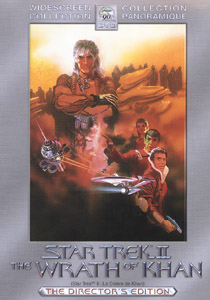
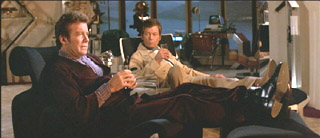 A friend and
self proclaimed movie connoisseur one day noted a fairly consistent phenomenon:
the second film in a series tends to be the best
when it comes to the Sci-Fi genre. Oh, it's not hard and fast but "The Empire Strikes Back",
"Aliens", and
"The Wrath of Khan" seem plausible examples. Widely regarded as a huge improvement
over the first Star Trek motion picture, Wrath of Khan is viewed by many as the best
Star Trek film. Characterized by it solid script, Paramount has issued
this new Directors Edition exclusively on DVD.
A friend and
self proclaimed movie connoisseur one day noted a fairly consistent phenomenon:
the second film in a series tends to be the best
when it comes to the Sci-Fi genre. Oh, it's not hard and fast but "The Empire Strikes Back",
"Aliens", and
"The Wrath of Khan" seem plausible examples. Widely regarded as a huge improvement
over the first Star Trek motion picture, Wrath of Khan is viewed by many as the best
Star Trek film. Characterized by it solid script, Paramount has issued
this new Directors Edition exclusively on DVD.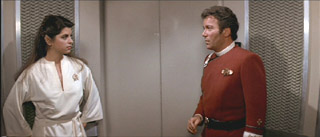 It is the 23rd century.
Aboard the U.S.S Enterprise, Admiral James T. Kirk seems resigned to the
fact that this may well be his last mission. But Khan, a brilliant
renegade of 20th century Earth, is back, and now schemes to set a most
deadly trap for his old enemy Kirk... with the threat of universal
Armageddon!
It is the 23rd century.
Aboard the U.S.S Enterprise, Admiral James T. Kirk seems resigned to the
fact that this may well be his last mission. But Khan, a brilliant
renegade of 20th century Earth, is back, and now schemes to set a most
deadly trap for his old enemy Kirk... with the threat of universal
Armageddon! Leonard Nimoy was
reticent to
once again don the pointed ears for the pivotal roll of Spock.
Convinced at the time that this would be the last Star Trek film, when
presented with a death scene (the holy grail for actors), he can't resist and
fortuitously
signs on. He and all the requisite actors play what could easily be
called the best performance of their Star Trek careers, and even Kirstie
Alley fits in as the up and coming Vulcan
officer.
Leonard Nimoy was
reticent to
once again don the pointed ears for the pivotal roll of Spock.
Convinced at the time that this would be the last Star Trek film, when
presented with a death scene (the holy grail for actors), he can't resist and
fortuitously
signs on. He and all the requisite actors play what could easily be
called the best performance of their Star Trek careers, and even Kirstie
Alley fits in as the up and coming Vulcan
officer. The then new effects company
ILM, George Lucas' Industrial Light and Magic, was used for all the visual
spectacles of the space adventure. Model, matting, and compositing work,
much of which was shot with the large gauge VistaVision format, are state of
their art. While computers for major visual effects would not be a
reality for almost a decade, Wrath of Khan features the first extensive use
of 3D computer graphics in Hollywood: The entire "demo tape" for the
Genesis Project as viewed by Kirk and company was done in CG.
The then new effects company
ILM, George Lucas' Industrial Light and Magic, was used for all the visual
spectacles of the space adventure. Model, matting, and compositing work,
much of which was shot with the large gauge VistaVision format, are state of
their art. While computers for major visual effects would not be a
reality for almost a decade, Wrath of Khan features the first extensive use
of 3D computer graphics in Hollywood: The entire "demo tape" for the
Genesis Project as viewed by Kirk and company was done in CG.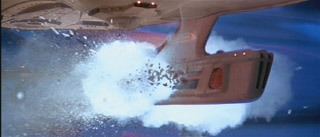 Disc 1 features a commentary
track by director Nicolas Meyer. While many single person tracks end
up being boring, Meyer amuses himself and us in the process, revealing not
so much the play-by-play of each scene, but more of the big picture.
Also available is a text-commentary by Star Trek Guru Michael Okuda
(co-author of The Star Trek Encyclopedia).
Disc 1 features a commentary
track by director Nicolas Meyer. While many single person tracks end
up being boring, Meyer amuses himself and us in the process, revealing not
so much the play-by-play of each scene, but more of the big picture.
Also available is a text-commentary by Star Trek Guru Michael Okuda
(co-author of The Star Trek Encyclopedia).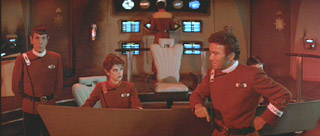 The set of original interviews
from 1982 are not as interesting as the new stuff, though seeing the crew in
early 80s fashion is somewhat amusing. There is the requisite
theatrical trailer and the always interesting story boards. These last
are not presented in a very fluid fashion, requiring you to navigate in and
out of sequences. This part of the disc actually caused one of our DVD players to
hang.
The set of original interviews
from 1982 are not as interesting as the new stuff, though seeing the crew in
early 80s fashion is somewhat amusing. There is the requisite
theatrical trailer and the always interesting story boards. These last
are not presented in a very fluid fashion, requiring you to navigate in and
out of sequences. This part of the disc actually caused one of our DVD players to
hang.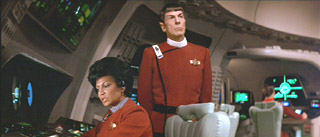 For
this new edition, a brand new interpostive was struck from the original
negative elements, including the material that Nick Meyer wished to be
included. The C-Reality system was used to transfer the new
interpostive to Hi Def, where defects from the original elements (dirt,
scratches etc) were cleaned up. The new High Definition master was
edited in a manner that incorporated all of the additional material (the TV version was used
as a guide).
For
this new edition, a brand new interpostive was struck from the original
negative elements, including the material that Nick Meyer wished to be
included. The C-Reality system was used to transfer the new
interpostive to Hi Def, where defects from the original elements (dirt,
scratches etc) were cleaned up. The new High Definition master was
edited in a manner that incorporated all of the additional material (the TV version was used
as a guide).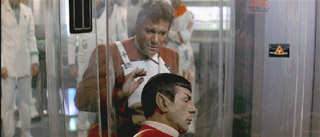 The following information only affects progressive scan display of the movie and has
no impact on interlaced displays. For an explanation of MPEG Picture
Flags, please see the section "How
the information is stored on disc" in
The following information only affects progressive scan display of the movie and has
no impact on interlaced displays. For an explanation of MPEG Picture
Flags, please see the section "How
the information is stored on disc" in 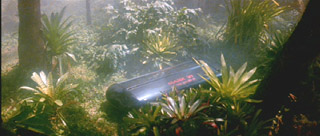 The
audio from a 70mm print master was captured and cleaned up for this release.
Laura Thornburg of Paramount Pictures explained to us that this source
soundtrack conformed to the classic 70mm six-track: 5 screen channels and
one surround. With that in mind, not a lot of re-mix work was called
for, save for a little steering here and there (surrounds especially), and of
course an LFE channel was derived in the 5.1 sound pallet. For the most
part we are hearing a track very close to what was heard by audiences at
70mm road show engagements two decades ago.
The
audio from a 70mm print master was captured and cleaned up for this release.
Laura Thornburg of Paramount Pictures explained to us that this source
soundtrack conformed to the classic 70mm six-track: 5 screen channels and
one surround. With that in mind, not a lot of re-mix work was called
for, save for a little steering here and there (surrounds especially), and of
course an LFE channel was derived in the 5.1 sound pallet. For the most
part we are hearing a track very close to what was heard by audiences at
70mm road show engagements two decades ago.

